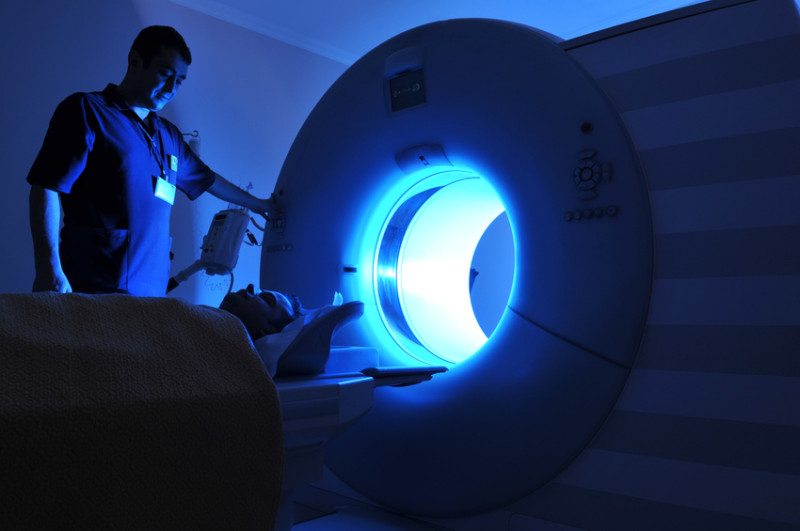
A way to scan young cancer patients' bodies for tumors without exposing them to radiation has been developed. The technique could reduce patients' risk of developing secondary cancers later in life. The new method is a modification of magnetic resonance imaging that employs a novel contrast agent to find tumors. The MRI-based method is as effective as cancer-detection scans that use ionizing radiation -- specifically, positron emission tomography-computed tomography -- the researchers found.
 Researchers at the Stanford University School of Medicine and Lucile Packard Children's Hospital Stanford have developed a way to scan young cancer patients' bodies for tumors without exposing them to radiation. The technique could reduce patients' risk of developing secondary cancers later in life.
Researchers at the Stanford University School of Medicine and Lucile Packard Children's Hospital Stanford have developed a way to scan young cancer patients' bodies for tumors without exposing them to radiation. The technique could reduce patients' risk of developing secondary cancers later in life.
The new method, described in a scientific paper that will be published Feb. 18 in The Lancet Oncology, is a modification of magnetic resonance imaging that employs a novel contrast agent to find tumors. The MRI-based method is as effective as cancer-detection scans that use ionizing radiation -- specifically, positron emission tomography-computed tomography -- the researchers found.
Although whole-body PET-CT technology provides essential information for detecting cancer, it has one big drawback: A single scan exposes the patient to as much radiation as 700 chest X-rays. This exposure is especially risky for children and teenagers, who are more vulnerable to radiation than adults because they are still growing. Children are also more likely to live long enough to develop a second cancer.
"I'm excited about having an imaging test for cancer patients that requires zero radiation exposure," said senior author Heike Daldrup-Link, MD, associate professor of radiology at Stanford and a diagnostic radiologist at the hospital. "That is a big deal."
The research team compared the modified MRI technique to standard PET-CTs in 22 patients ages 8 to 33 who had lymphoma or sarcoma. These cancers originate in the immune system and the bones, respectively. Both cancers can spread throughout tissues such as bone marrow, lymph nodes, liver and spleen.
In the past, several hurdles prevented physicians from using whole-body MRIs to look for tumors. The scans take up to two hours. A whole-body PET-CT, however, takes only a few minutes. (It combines PET images taken by monitoring the metabolism of radioactive glucose with CT images, which are essentially a series of X-rays from different angles.) More importantly, in many organs, MRI does not distinguish healthy from cancerous tissue. And existing contrast agents -- chemicals injected into the body to make tumors visible -- leave the tissues too quickly to be used in a lengthy, whole-body MRI.
To find tumors via MRI, the Stanford team used a new contrast agent consisting of nanoparticles of iron. Injections of these iron nanoparticles are approved by the Food and Drug Administration to treat anemia, and the researchers obtained FDA permission for the experimental use. The nanoparticles are retained in the body for many days. On MRIs, they cause blood vessels to appear brighter, providing anatomic landmarks. The nanoparticles also cause healthy bone marrow, lymph nodes, liver and spleen to appear darker, making tumors stand out.
The images generated from the experimental MRIs provided comparable information to the PET-CT scans that study subjects received as part of their care. The PET-CTs detected 163 of 174 total tumors in the 22 patients; the MRIs found 158 of 174 tumors. The two methods had similar levels of sensitivity, specificity and diagnostic accuracy.
"We were able to find a new way to integrate anatomical and physiological MRI information and make it more efficient," said Christopher Klenk, MD, a postdoctoral scholar and the paper's lead author.
None of the patients experienced adverse reactions to the iron nanoparticles, though the FDA has previously noted a small risk of allergic reaction to the nanoparticles' coating. (It's rare for patients to have adverse reactions to other contrast agents, too.)
Radiologists at several academic hospitals are searching for ways to reduce children's radiation exposure, Daldrup-Link said, adding that she is sharing the new technique with colleagues around the country.
"Some type of whole-body MRI imaging test is available at many big children's hospitals right now," she said, adding that for such techniques to be widely adopted, doctors are asking for evidence that whole-body MRI does the job. "It's slowly entering clinical practice, but clinicians are cautious and want to be convinced," she added. The other barrier to wide adoption of MRI-based tests is lack of a billing code, a hurdle the researchers hope will soon be resolved. But there are no technologic obstacles to use of the new technique.
"It's really exciting that this will soon be clinically applicable," Daldrup-Link said.
Future research will aim to validate the MRI-based method in larger, more diverse groups of cancer patients, as well as examine its possible use for monitoring tumors over the course of cancer treatment. The MRI-based method also holds promise for scanning patients after their treatment is complete, when the ability to monitor them without radiation would be especially valuable.

 Previous page
Previous page Back to top
Back to top







